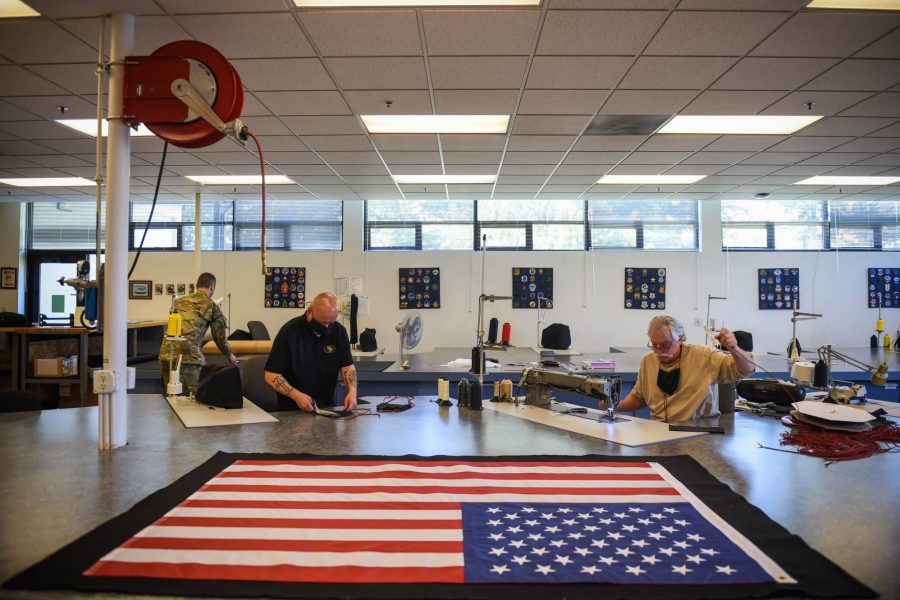Total Force Airmen and members of the USAF community are using high- and low-tech methods to manufacture personal protective equipment for use in the fight against the new coronavirus pandemic.
Some of these efforts predated the Defense Department’s April 5 guidance mandating the wear of fabric-based face coverings at all U.S. military installations.
Airmen from the Alaska Air National Guard’s 168th Wing are using 3D printing to manufacture “a functional respirator mask” that could serve as an alternative to N95 particulate respirators. The masks are reserved for use by medical Airmen responding to the new coronavirus pandemic, according to a 168th Wing release.
“Some of our jobs demand PPE-like masks, but we’re trying not to use them,” 168th Maintenance Group Commander Lt. Col. Jennifer Casillo said in the release.
A team led by 168th Aircraft Maintenance Squadron production superintendent Senior Master Sgt. Ray Allen scoured Internet forums for potential designs, with different levels of success, before settling on a design known as “the Montana Mask,” the release said.

The mask design, which was brainstormed by a neurosurgeon from the state, is plastic, washable, and sterilizable, and uses replaceable paper filters. “Although not yet approved by any state or federal regulating institute, early testing shows the mask to be effective if fitted properly,” the release noted.
Air Force Repair Enhancement Program Airmen from Hill Air Force Base, Utah, and Tyndall Air Force Base, Fla., are undertaking similar efforts at their bases, the latter at the request of Chief Master Sgt. Katherine Grabham, the 325th Fighter Wing Command Chief.
Airmen from Travis Air Force Base, Calif., Nellis Air Force Base, Nev., and the Massachusetts Air National Guard’s 104th Fighter Wing are also using additive manufacturing to help their fellow Airmen.
At Travis, Airmen from the 60th Air Mobility Wing Phoenix Spark innovation cell, the 60th Maintenance Squadron, and the 60th Bioenvironmental Engineering Squadron joined forces to prototype and produce N95 mask covers and face shields for use by medics from the David Grant U.S. Air Force Medical Center, according to an April 12 wing release.
“The current designs are very simplistic to enhance our ability to mass produce them,” Staff Sgt. Maximilion Estrada, Phoenix Spark non-commissioned officer in charge of agile manufacturing, said in the release.
The resulting PPE aims to extend the life of N95 respirators used by the medics.

At Nellis, a team of 57th Aircraft Maintenance Squadron Airmen led by Tech. Sgt. Matthew Bobbitt, a resource advisor with the squadron, is 3D printing headbands to be used as part of face shields for the 99th Medical Group, according to a base release. The final products cost about $4 each to print and minimal additional supplies to assemble, the release explained, noting that the team is using software distributed by the National Institutes of Health to produce them.
“The question came up of what we [in the Maintenance Group] can do to be able to help, so I began researching and found that face shields are the most effective personal protective equipment that can be currently produced,” Bobbitt said in the release.

And in Massachusetts, explosive ordnance disposal Airmen are using a 3D printer typically used to create “simulated training materials” to make face shields for use by the 104th Fighter Wing Medical Group colleagues, a wing release explained.

Other Air Force organizations are using lower-fi methods to contribute to the effort.
Airmen from the 62nd Operations Support Squadron fabrication shop at Joint Base Lewis-McChord, Wash., started fashioning cloth face coverings “from cotton material typically used on aircraft seats and cords used in parachutes” on April 6, a 62nd Airlift Wing release said. The masks are destined for McChord Field airmen who’ve been deemed mission-essential.
The 437th Operations Support Squadron at Joint Base Charleston, S.C., has also started sewing cloth-based masks, and had made over 500 of them as of April 8, according to photos published by the base.

At Altus Air Force Base, Okla., 97th Air Mobility Wing Commander Col. Matthew Leard implemented a two-day pause so the wing could figure out how to get masks for and to its Airmen, an April 6 release said. Airmen and civilian volunteers there are also sewing masks for use by wing personnel, the release noted.
USAF Airmen based overseas are also getting into the creative spirit.
The 48th Fighter Wing at RAF Lakenheath, England, has transformed part of its Arts and Crafts Center into a makeshift mask factory, 48th Community Service Flight Superintendent Master Sgt. Tennille Benton explained in an April 9 release.

“We’ve taken our paint and ceramics room and turned it into our sewing room,” Benton said in the release. “We’ll use that space to produce enough masks to supply to our military members in the 48th Fighter Wing.”
The center also created DIY mask-making kits so volunteers could support the effort from home, according to the release.
“With the current supply of material, the Arts and Crafts center hopes to make and distribute more than 685 [masks] to base personnel across the wing,” the release stated.

And Staff Sgt. Kalynn Mitchell, a solar analyst with the 2nd Weather Squadron who is currently based in Exmouth, Australia, is sewing fabric masks for healthcare workers and vulnerable community members, according to a 55th Wing release.
The daughter of a respiratory therapist, Mitchell said she was disturbed by PPE shortages for medical professionals, as well as by the fact these workers are being advised to reuse PPE.
“I wanted to help in any way that I could,” she said in the release.
Air Force family members are also getting into the effort.
Robins Mask Makers, a Facebook group composed of nearly 38 military spouses, has fabricated more than 5,000 masks for use by troops at Robins Air Force Base, Ga., as of April 12, according to a 505th Command and Control Wing release.
